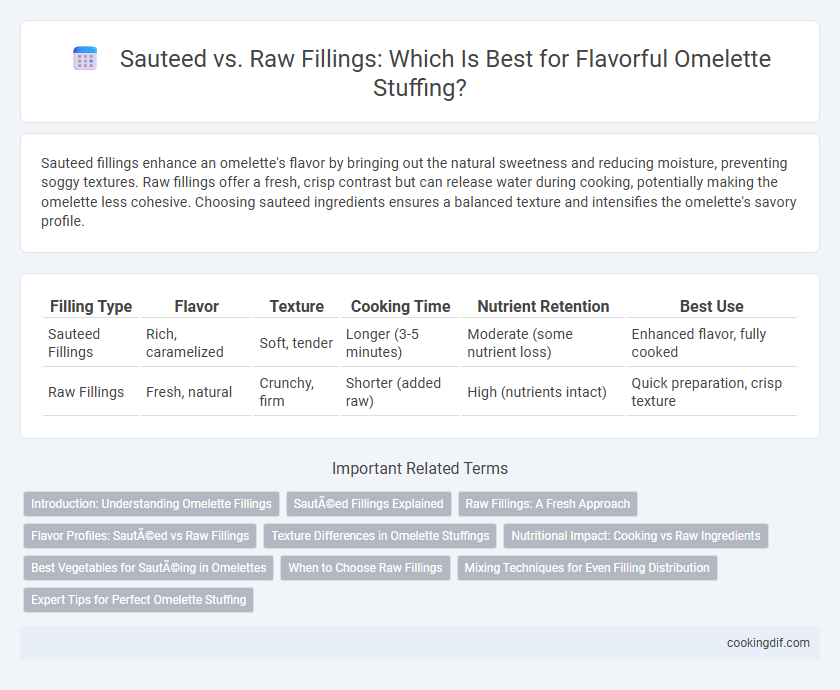Sauteed fillings enhance an omelette's flavor by bringing out the natural sweetness and reducing moisture, preventing soggy textures. Raw fillings offer a fresh, crisp contrast but can release water during cooking, potentially making the omelette less cohesive. Choosing sauteed ingredients ensures a balanced texture and intensifies the omelette's savory profile.
Table of Comparison
| Filling Type | Flavor | Texture | Cooking Time | Nutrient Retention | Best Use |
|---|---|---|---|---|---|
| Sauteed Fillings | Rich, caramelized | Soft, tender | Longer (3-5 minutes) | Moderate (some nutrient loss) | Enhanced flavor, fully cooked |
| Raw Fillings | Fresh, natural | Crunchy, firm | Shorter (added raw) | High (nutrients intact) | Quick preparation, crisp texture |
Introduction: Understanding Omelette Fillings
Sauteed fillings for omelettes enhance flavor and texture by caramelizing vegetables and cooking proteins, resulting in a richer taste and softer bite. Raw fillings, while quicker and fresher, may release moisture that can dilute the omelette and affect its consistency. Choosing sauteed ingredients like mushrooms, onions, or peppers improves the overall omelette experience by balancing moisture and intensifying flavor.
Sautéed Fillings Explained
Sauteed fillings for omelettes enhance flavor and texture by allowing ingredients like onions, peppers, and mushrooms to caramelize and soften before being folded into the eggs. This cooking method intensifies the natural sugars and aromas, creating a richer taste profile compared to raw fillings. Using sauteed fillings also ensures even cooking and prevents excess moisture from making the omelette soggy.
Raw Fillings: A Fresh Approach
Raw fillings in omelettes offer a fresh approach by preserving the natural flavors and nutrients of ingredients like tomatoes, spinach, and onions. Using raw vegetables or herbs enhances the vibrant texture and color contrast, creating a light and flavorful stuffing option. This method requires precise timing to balance the omelette's doneness with the freshness of the fillings without overcooking.
Flavor Profiles: Sautéed vs Raw Fillings
Sauteed fillings for omelettes develop deeper, caramelized flavors through the Maillard reaction, enhancing sweetness and umami in ingredients like onions, mushrooms, and bell peppers. Raw fillings provide a fresher, crisper texture and retain bright, sharp flavors, ideal for ingredients like tomatoes, spinach, and herbs. The choice between sauteed and raw fillings significantly influences the omelette's overall flavor profile by balancing richness and freshness.
Texture Differences in Omelette Stuffings
Sauteed fillings in omelettes offer a tender, slightly caramelized texture that enhances flavor integration, contrasting with raw fillings which provide a crisp, fresh bite that preserves individual ingredient identity. Cooking fillings like mushrooms, onions, or bell peppers softens their structure, creating a cohesive, melt-in-the-mouth experience. Raw additions such as spinach or fresh tomatoes contribute a juicy, crunchy texture, adding dynamic contrast to the smoothness of the egg.
Nutritional Impact: Cooking vs Raw Ingredients
Sauteed fillings for omelettes, such as vegetables and meats, often provide enhanced nutrient bioavailability due to the breakdown of cell walls and release of antioxidants like carotenoids and lycopene during cooking. Raw fillings retain more heat-sensitive vitamins such as vitamin C and some B vitamins but may contain natural enzyme inhibitors and anti-nutrients that reduce overall nutrient absorption. Choosing sauteed over raw fillings optimizes digestibility and nutrient uptake while balancing the preservation of heat-sensitive vitamins.
Best Vegetables for Sautéing in Omelettes
Sauteed fillings in omelettes enhance flavor and texture compared to raw vegetables, offering a richer taste and better caramelization. The best vegetables for sauteing in omelettes include bell peppers, mushrooms, spinach, onions, and zucchini, as they release their natural sweetness and maintain a tender consistency. These sauteed vegetables integrate seamlessly with eggs, creating a balanced and savory omelette stuffing.
When to Choose Raw Fillings
Raw fillings for omelette stuffing are ideal when using delicate ingredients like fresh herbs, leafy greens, or thinly sliced vegetables that require minimal cooking to retain their texture and flavor. Choosing raw fillings preserves the natural crunch and vibrant taste, enhancing the overall omelette experience. Opting for raw ingredients suits quick preparation and dishes where fresh, bright flavors are desired.
Mixing Techniques for Even Filling Distribution
Sauteing fillings like mushrooms, bell peppers, or onions before adding them to an omelette enhances flavors and reduces moisture, preventing sogginess while promoting even cooking. Mixing sauteed fillings into beaten eggs ensures an even distribution of ingredients throughout the omelette, resulting in a consistent texture and balanced taste. Using raw fillings without pre-cooking can lead to uneven moisture release and clumping, making it harder to achieve uniform filling dispersion during cooking.
Expert Tips for Perfect Omelette Stuffing
Sauteed fillings like mushrooms, onions, and bell peppers enhance the omelette's flavor by releasing their natural sugars and softening textures, preventing excess moisture that can make the omelette soggy. Expert tips recommend cooking fillings until just tender to maintain a balance of texture and taste, avoiding raw ingredients such as tomatoes or spinach unless properly drained or wilted. Properly sauteed fillings ensure even heat distribution, enriching the overall flavor profile and creating a perfectly stuffed omelette with optimal consistency.
Sautéed fillings vs raw fillings for omelette stuffing Infographic

 cookingdif.com
cookingdif.com